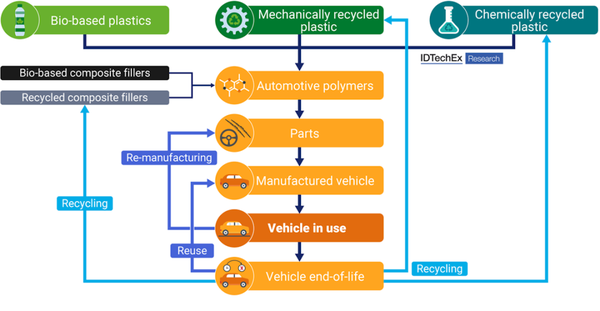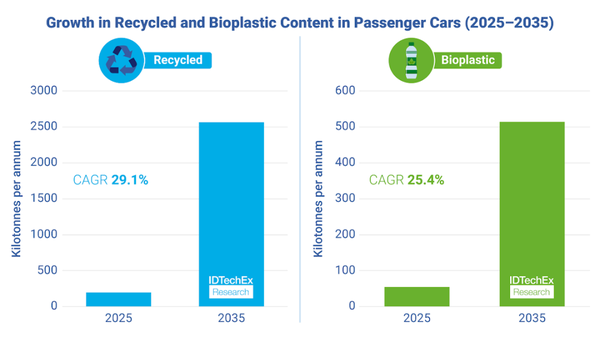Regenerated Plastic vs. Bioplastic: Which Will Dominate the Sustainable Automotive Future?
By 2035, the amount of recycled plastic used in cars reached 2.567 million tons, and the amount of bioplastic reached 513,000 tons.
In the global wave of sustainable transformation in the automotive industry, the environmental friendliness of plastic materials has become a key challenge. The high carbon emissions, resource dependency, and recycling difficulties of traditional fossil-based plastics are prompting automakers to seek alternatives. The latest report from IDTechEx, "Sustainable Plastics in Automotive 2025-2035: Markets, Players, and Forecasts," indicates that recycled plastics and bioplastics will become the two core directions in the next decade, but their development paths and market potentials show significant differences.
I. Sustainability Challenges of Automotive Plastics
The automotive industry consumes over 14 million tons of plastics annually, primarily derived from fossil fuels, leading to a high carbon footprint and dependence on the volatility of the oil market. Mandatory policies in regions like the EU, such as the requirement for vehicles to contain 25% recycled plastics by 2025, along with carbon tax pressures, are compelling automakers to accelerate the transition to sustainable materials.
However, the promotion of sustainable plastics faces multiple obstacles:
Material Performance and Cost: The recycling of complex polymers and composites is difficult, and the supply chain for bioplastics is immature and costly.
Application Scenario Differences: Single materials (such as polypropylene interiors) are relatively easy to recycle, while the recycling of special components (such as composite materials) still faces technical bottlenecks.
Automotive Plastic Circular Economy

Growth in Recycled and Bioplastic Content in Passenger Vehicles (2025-2035)

II. Recycled Plastics: The "Practical Choice" Dominating in the Short Term
Mechanical recycling is currently the most mature solution, achieving plastic circularity through crushing, melting, and remolding without altering the chemical structure. Its advantages include:
Policy-driven: EU regulations directly promote the application of mechanically recycled plastics.
Cost and Infrastructure: The existing recycling system supports its rapid implementation, and some automakers have already adopted recycled polypropylene in components such as seats and dashboards.
Chemical recycling breaks down plastics into monomers or raw materials, restoring material properties, but the technology is still in its early stages, with high costs and limited scalability. The report predicts that the global use of recycled plastics in automobiles will grow at a compound annual growth rate (CAGR) of 29.1% from 2025 to 2035, reaching 2.567 million tons by 2035, making it the short-term mainstream solution.
III. Bioplastics: Potential and Challenges Coexist
Bioplastics, made from renewable biomass such as plants and algae, theoretically reduce fossil fuel dependence. However, their development is currently limited by:
Supply chain bottlenecks: Limited production of bio-based polymers (such as bio-polypropylene and bio-polyamides), potential land competition arising from dependence on agricultural resources.
Cost disadvantage: The production cost of bioplastics is 30%-50% higher than that of conventional plastics, and they are only used in small quantities in high-end interiors (such as bio-based leather).
The report predicts that the global use of bioplastics in automobiles will grow at a CAGR of 25.1%, but by 2035, it will only account for 18% of the total automotive plastics, with usage reaching 513,000 tons, far below the sustainability targets set by automakers.
Four, industry pain points and breakthrough directions
Although the prospects for recycled plastics and bioplastics are promising, the industry still needs to address the following issues:
Technological Innovation: Develop recycling technologies suitable for complex components to enhance the durability and cost competitiveness of bioplastics.
Policy coordination: Strengthen global regulatory consistency and promote investment in circular economy infrastructure (such as chemical recycling plants).
Supply chain collaboration: automobile companies need to work with material suppliers and recycling companies to optimize the full lifecycle management from production to disposal.
Five, Future Outlook
IDTechEx predicts that by 2035, sustainable plastics will account for only 18% of the total automotive plastics, indicating that the industry needs to accelerate its transformation. In the short term, recycled plastics will dominate the market due to policy support and mature technology; in the long term, bioplastics, if they overcome technical and cost barriers, may complement recycled materials. Additionally, sustainable composite materials, tire innovations (such as bio-based elastomers, self-healing materials), and circular economy models (such as mono-material design) will also become important directions.
Conclusion
Regenerative plastics are a "must-have" for achieving sustainability goals today, while bioplastics are the "promising contenders" for a long-term low-carbon vision. Automakers need to take a multi-pronged approach by complying with policies, innovating technologically, and integrating supply chains, while also exploring diverse solutions (such as recyclable composites and bio-based alternatives) to achieve deeper sustainable transformation by the 2030s.
【Copyright and Disclaimer】The above information is collected and organized by PlastMatch. The copyright belongs to the original author. This article is reprinted for the purpose of providing more information, and it does not imply that PlastMatch endorses the views expressed in the article or guarantees its accuracy. If there are any errors in the source attribution or if your legitimate rights have been infringed, please contact us, and we will promptly correct or remove the content. If other media, websites, or individuals use the aforementioned content, they must clearly indicate the original source and origin of the work and assume legal responsibility on their own.
Most Popular
-

List Released! Mexico Announces 50% Tariff On 1,371 China Product Categories
-

Nissan Cuts Production of New Leaf EV in Half Due to Battery Shortage
-

New Breakthrough in Domestic Adiponitrile! Observing the Rise of China's Nylon Industry Chain from Tianchen Qixiang's Production
-

Dow, Wanhua, Huntsman Intensively Raise Prices! Who Controls the Global MDI Prices?
-

Mexico officially imposes tariffs on 1,400 chinese products, with rates up to 50%






